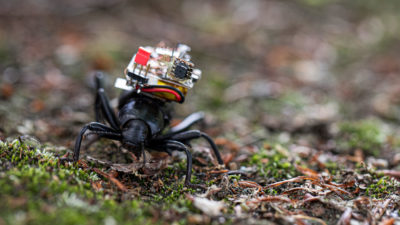Researchers at the University of Washington have developed a tiny camera that can ride aboard an insect or an insect-sized robot. Mark Stone/University of Washington
Scientists at the University of Washington have developed a tiny, wireless camera small enough to be worn by insects. The device weighs 250 milligrams — one-tenth the weight of a playing card — and streams high-resolution video to a smartphone at up to 5 frames per second, allowing scientists for the first time to record video of what insects see in real time.
The new device, whose development was announced in the journal Science Robotics, has a mechanical arm that lets the camera pivot 60 degrees, allowing for black-and-white panoramic shots. When scientists want to move the arm, they apply a high voltage that makes the material bend to the desired position. The camera will stay there for about a minute before relaxing back to its front-facing position. The system, which is controlled by a smartphone app and can operate from as far as 120 meters away, allowed the scientists to avoid using heavy batteries to power the insect-sized camera. They tested the systems on a death-feigning beetle and a Pinacate beetle.
“We made sure the beetles could still move properly when they were carrying our system,” Ali Najafi, a University of Washington doctoral student in electrical and computer engineering who co-authored the new research, said in a statement. “They were able to navigate freely across gravel, up a slope, and even climb trees.”
The researchers said the new camera system will enable scientists to better understand insect behavior and explore novel environments, as well as help develop the next generation of small robots.
“This is the first time that we’ve had a first-person view from the back of a beetle while it’s walking around. There are so many questions you could explore, such as how does the beetle respond to different stimuli that it sees in the environment?” said Vikram Iyer, another co-author and UW doctoral student. “But also, insects can traverse rocky environments, which is really challenging for robots to do at this scale. So this system can also help us out by letting us see or collect samples from hard-to-navigate spaces.”



